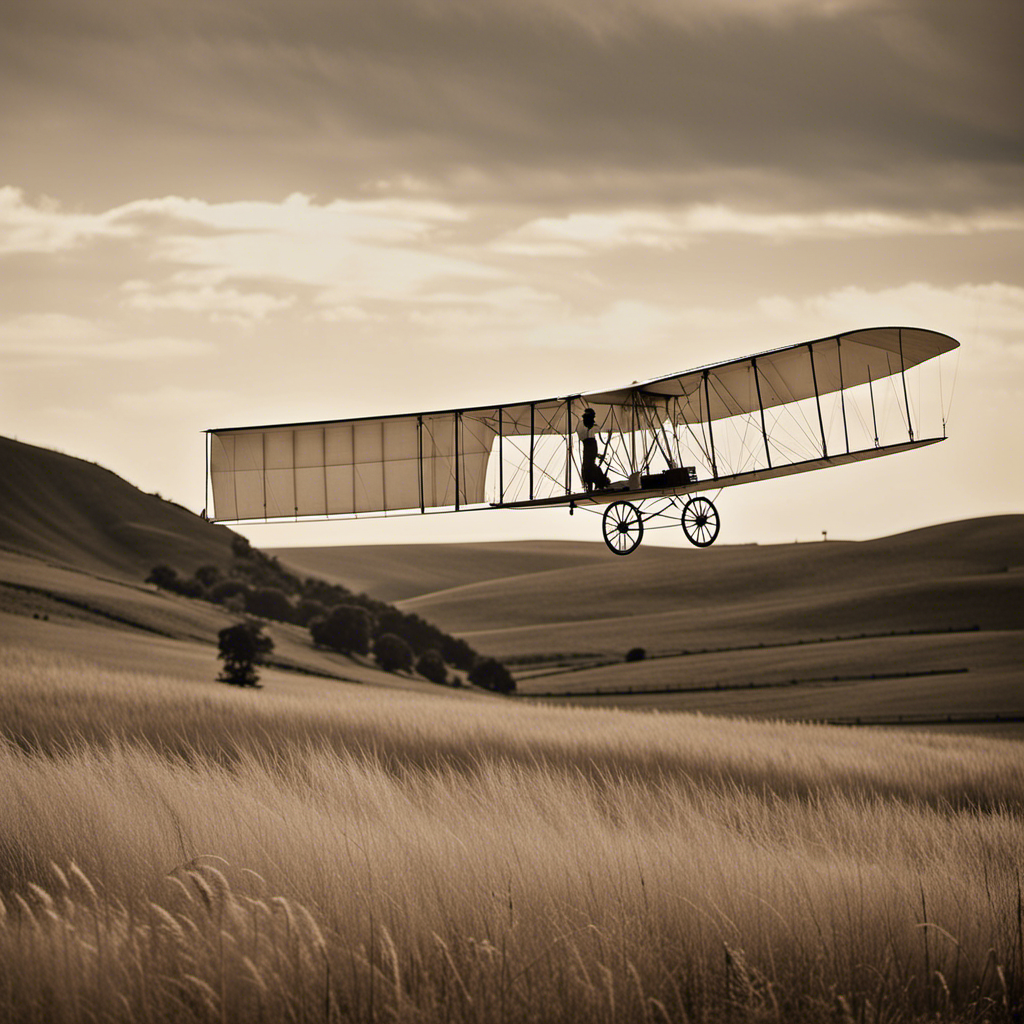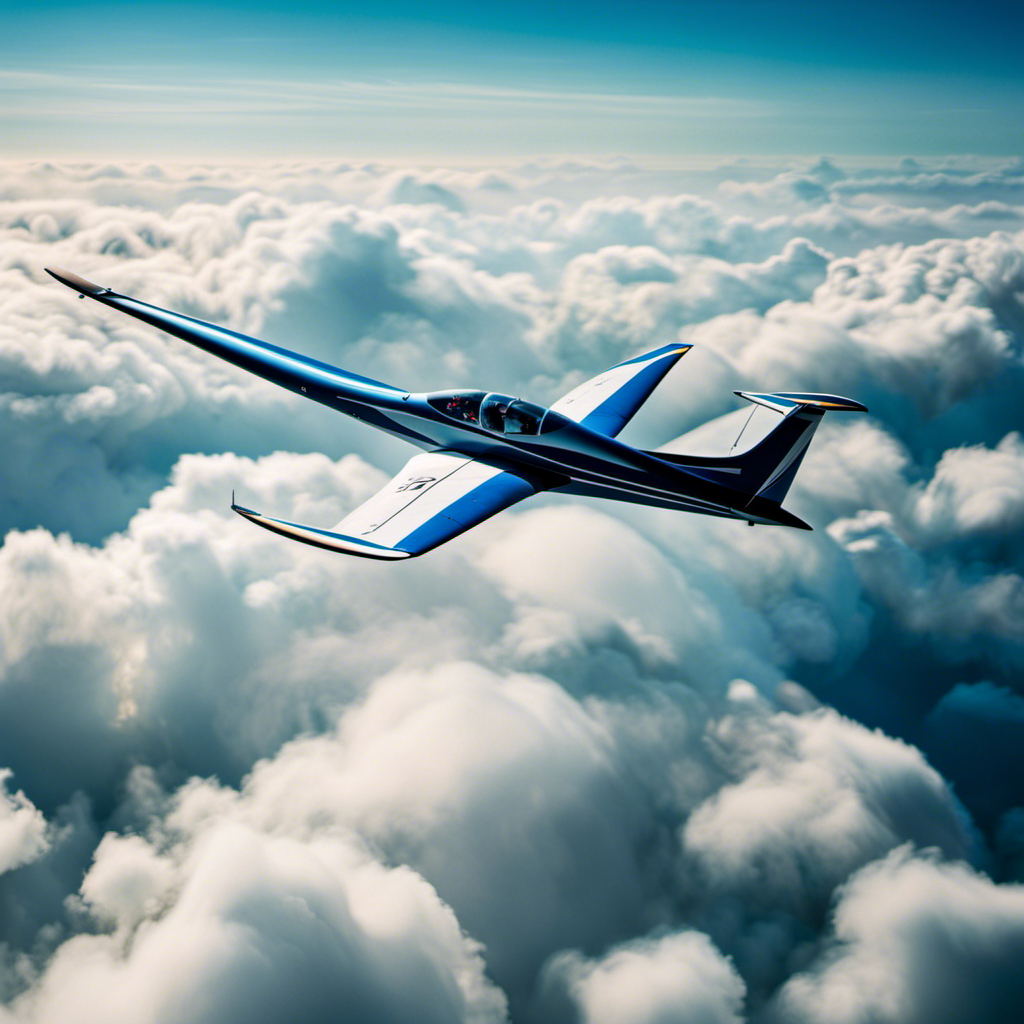As a passionate aviation enthusiast, I often ponder which came first: the glider or the airplane? It’s like exploring historical depths, reflecting on the origins of air travel.
In this article, we will explore the early experiments with gliders, the groundbreaking achievements of the Wright Brothers and their first powered flight, and the role that gliders and planes have played in shaping the course of aviation history.
Join me on this journey as we delve into the fascinating evolution of flight.
Key Takeaways
- Gliders were developed before planes, with early experiments dating back to the observation of birds and their ability to fly effortlessly.
- The Wright brothers achieved the first powered flight, but gliders played a significant role in their journey to powered flight and served as a stepping stone for the development of planes.
- Otto Lilienthal made significant contributions to glider development, revolutionizing the field of glider flight and inspiring future aviation pioneers like the Wright brothers.
- Gliders and planes revolutionized aviation technology, leading to advancements in aerodynamics, engine development, and control systems, and paving the way for the development of modern aircraft.
The Origins of Flight
The origins of flight can be traced back to the development of gliders and planes. Early human flight has always been a fascination for mankind. Throughout history, humans have dreamt of soaring through the skies like birds. Technological advancements played a crucial role in turning this dream into reality.
In the early stages, humans observed birds and their ability to fly effortlessly. This led to the development of gliders, which were essentially large wings that allowed humans to glide through the air. These early experiments with gliders paved the way for future advancements in aviation.
Technological progress further fueled the desire to conquer the sky. Inventors and engineers began to experiment with different designs and mechanisms to achieve powered flight. It was the Wright brothers, Orville and Wilbur, who successfully built and flew the first powered airplane in 1903. This monumental achievement marked a turning point in the history of aviation.
The development of gliders and planes was driven by a deep-rooted human desire to conquer the skies. Through technological advancements, humans were able to fulfill this dream and achieve the seemingly impossible. With the introduction of powered flight, a new era in aviation began, propelling us towards the modern aircraft we see today.
Early Experiments with Gliders
Before the Wright brothers achieved powered flight, early aviators experimented with gliders to test the principles of aerodynamics. These early pioneers of flight were eager to unlock the secrets of the sky, pushing the boundaries of what was possible with their innovative designs. Through their flight experiments, they hoped to understand the forces at play and how to harness them for controlled flight.
In order to evoke an emotional response in the audience and better understand the challenges faced by these early pioneers, I have created a table that highlights the key figures and their glider designs:
| Aviator | Glider Design |
|---|---|
| Otto Lilienthal | Curved Wing Glider |
| Octave Chanute | Multi-wing Glider |
| Samuel Langley | Tandem-wing Glider |
| Percy Pilcher | Box Kite Glider |
These aviators dedicated countless hours to perfecting their gliders, often risking their lives in the pursuit of knowledge. Their determination and passion laid the foundation for future advancements in aviation.
With their experiments and innovations, these early pioneers paved the way for the next chapter in aviation history: the Wright brothers and the first powered flight.
The Wright Brothers and the First Powered Flight
You can’t deny the impact the Wright brothers had on aviation when they achieved powered flight. Their achievements as aviation pioneers are truly remarkable. The Wright brothers, Orville and Wilbur, were not only skilled engineers but also meticulous researchers. They understood the principles of flight and spent years conducting experiments and making advancements in aeronautics. Finally, on December 17, 1903, at Kitty Hawk, North Carolina, they successfully flew their powered aircraft, the Wright Flyer, for a distance of 120 feet in 12 seconds. This pivotal moment marked the beginning of a new era in aviation.
The Wright brothers’ achievement of powered flight revolutionized the world and paved the way for modern aviation. Their meticulous research and attention to detail in areas such as wing design, control systems, and engine development set the foundation for future aircraft design. Not only did they design and build the first successful powered aircraft, but they also introduced essential concepts like three-axis control, which allows pilots to maneuver their aircraft effectively.
The role of gliders in aviation history is significant as well. Gliders played a crucial role in the Wright brothers’ journey to powered flight. They began their experiments with gliders, testing and refining their understanding of lift, drag, and control. Gliders allowed them to gain valuable insights into the principles of flight, which they later applied to their powered aircraft. Gliders were a stepping stone for the Wright brothers, enabling them to understand the aerodynamics and control necessary for successful flight.
Transitioning to the subsequent section about the role of gliders in aviation history, it is essential to recognize the significance of these early experiments as they laid the groundwork for future advancements in aviation technology.
The Role of Gliders in Aviation History
When discussing the role of gliders in aviation history, it is impossible to overlook the contributions of Otto Lilienthal.
Lilienthal, often referred to as the ‘Glider King,’ made significant advancements in the field of aviation through his experiments and designs.
His gliders not only paved the way for manned flight but also had a profound influence on the development of aircraft design, shaping the principles that still guide engineers today.
Otto Lilienthal and His Contributions
Otto Lilienthal, a German aviation pioneer, made significant contributions to the development of gliders in the late 19th century. His early experiments with gliders laid the foundation for modern aviation.
Lilienthal’s meticulous study of aerodynamics and his innovative design concepts revolutionized the field of glider flight. He conducted extensive research on lift and drag, developing a deep understanding of the principles that govern flight.
Through his experiments, Lilienthal was able to design gliders that could achieve sustained and controlled flight. His work not only provided valuable insights into the mechanics of flight but also inspired future aviation pioneers, such as the Wright brothers, who built upon his ideas.
Lilienthal’s contributions to the field of gliders played a crucial role in shaping the subsequent advancements in aircraft design.
The Influence of Gliders on Aircraft Design
The Wright brothers were inspired by Otto Lilienthal’s innovative ideas and applied them to their own aircraft designs. Lilienthal’s gliders had a significant influence on the development of aerodynamics and the design of future aircraft.
Here are four ways in which gliders influenced aircraft design:
-
Understanding Lift: Lilienthal’s experiments with gliders helped to refine our understanding of how wings generate lift, a crucial concept in aviation.
-
Stability and Control: By studying how gliders maintained stability and control in flight, engineers were able to develop more maneuverable and controllable aircraft.
-
Wing Design: Lilienthal’s gliders showcased the importance of a curved wing shape, which led to the development of the modern airfoil design still used in aircraft today.
-
Military Applications: The success of gliders in early aviation influenced military strategies, leading to the use of gliders for reconnaissance and troop transportation in the early 20th century.
These advancements in aerodynamics and aircraft design laid the foundation for the subsequent advancements in aircraft technology.
The Advancements in Aircraft Technology
You’ll be amazed at the advancements in aircraft technology. Over the years, there have been significant developments in aerodynamics and other aspects of aviation. These advancements have not only revolutionized the way we travel but have also had a profound impact on the economy.
One of the key advancements in aircraft technology is the improvement in aerodynamics. Engineers have been able to design aircraft with sleeker and more streamlined shapes, reducing drag and enhancing fuel efficiency. This has not only made air travel faster but also more cost-effective. The advancements in materials and manufacturing processes have further contributed to the overall performance of aircraft, making them lighter, stronger, and more reliable.
The impact of aviation on the economy cannot be overstated. Air travel has become an integral part of global trade and commerce. It has facilitated the transportation of goods and people across vast distances, connecting businesses and markets like never before. The aviation industry has created millions of jobs worldwide, ranging from pilots and flight attendants to engineers and technicians. It has also spurred the growth of related industries, such as tourism and hospitality.
As we delve into the impact of gliders and planes on society, it is essential to recognize the immense progress made in aircraft technology. These advancements have not only revolutionized the way we fly but have also transformed our economy and opened up new opportunities for growth and development.
The Impact of Gliders and Planes on Society
Aviation has had a profound impact on society, transforming the way we travel and connecting people across the globe. The economic impact of gliders and planes cannot be overstated. These flying machines have opened up new opportunities for trade, tourism, and business. They have made it possible for people to travel long distances in a matter of hours, facilitating global commerce and boosting economies worldwide. Moreover, the aviation industry itself has become a significant contributor to the global economy, creating jobs and generating revenue.
However, it’s important to consider the environmental impact of aviation as well. The burning of fossil fuels by aircraft engines contributes to greenhouse gas emissions and air pollution, which have negative effects on the environment and human health. Efforts are being made to develop more fuel-efficient and eco-friendly aircraft to mitigate these impacts.
Transitioning into the subsequent section about the role of gliders and planes in scientific research, it is fascinating to explore how these flying machines have revolutionized our understanding of the world around us.
The Role of Gliders and Planes in Scientific Research
After exploring the impact of gliders and planes on society, it is fascinating to delve into the role of these aircraft in scientific research. Gliders, in particular, have proven to be invaluable tools for environmental research and weather forecasting.
Gliders are uniquely suited for conducting research in the Earth’s atmosphere and oceans. Equipped with various sensors and instruments, they can collect data on temperature, humidity, wind patterns, and other atmospheric parameters. This data is crucial for understanding weather patterns, climate change, and the overall health of our planet.
In weather forecasting, gliders play a vital role in improving the accuracy and reliability of predictions. By gathering real-time data from the lower atmosphere, gliders provide meteorologists with a more comprehensive understanding of atmospheric conditions. This information enables them to make more precise forecasts and issue timely warnings for severe weather events.
Furthermore, gliders are used to study the oceans and marine ecosystems. They can measure ocean currents, salinity levels, and the distribution of marine life. This data helps scientists monitor and assess the impact of climate change on the world’s oceans, as well as study the behavior of marine species.
The Future of Flight
When it comes to the future of flight, two key areas of focus are electric and sustainable aircraft, as well as hypersonic and supersonic travel.
Electric and sustainable aircraft have the potential to revolutionize the aviation industry by reducing carbon emissions and dependence on fossil fuels.
On the other hand, hypersonic and supersonic travel aim to drastically reduce travel times, allowing passengers to reach their destinations faster than ever before.
Electric and Sustainable Aircraft
Electric and sustainable aircraft are becoming increasingly popular in the aviation industry. With advancements in technology and growing concerns about environmental impact, electric aviation has emerged as a promising solution.
Sustainable aircraft design focuses on reducing carbon emissions and minimizing the use of fossil fuels. Electric aircraft, powered by batteries or fuel cells, offer a cleaner and more efficient alternative to traditional combustion engines. These aircraft produce zero or significantly lower emissions, resulting in reduced air pollution and noise pollution.
Moreover, sustainable aircraft design also includes using lightweight materials and aerodynamic features to enhance fuel efficiency. As the demand for eco-friendly transportation grows, the development and adoption of electric and sustainable aircraft will continue to play a crucial role in shaping the future of aviation.
Transitioning into the next section, let’s explore the exciting advancements in hypersonic and supersonic travel.
Hypersonic and Supersonic Travel
As we delve into hypersonic and supersonic travel, it’s important to understand the incredible speed and potential of these aircraft.
Hypersonic propulsion, which involves speeds greater than Mach 5, has the ability to revolutionize air travel by significantly reducing travel times.
Supersonic aircraft designs, on the other hand, focus on speeds between Mach 1 and Mach 5, offering faster travel without the extreme technical challenges of hypersonic flight. These aircraft are engineered with advanced aerodynamics, efficient engines, and lightweight materials to achieve such high speeds.
The development of hypersonic and supersonic travel opens up possibilities for faster and more efficient transportation, allowing people to reach their destinations in a fraction of the time.
However, as we explore this exciting realm of aviation, it is crucial to also consider the importance of aviation safety and regulations, ensuring that these advancements are implemented responsibly and with the highest level of precaution.
The Importance of Aviation Safety and Regulations
You should always prioritize aviation safety by following regulations and guidelines. Aviation regulations are in place to ensure the safety of everyone involved in the aviation industry, including pilots, passengers, and ground crew.
These regulations cover a wide range of safety measures, such as aircraft maintenance, pilot training and licensing, air traffic control procedures, and emergency response protocols.
One of the most important aspects of aviation safety is the adherence to proper maintenance procedures. Regular inspections and maintenance checks are required to ensure that aircraft are in good working condition and meet all safety standards. Additionally, pilots must undergo rigorous training and obtain the necessary licenses to operate an aircraft safely.
Another crucial safety measure is effective air traffic control. Air traffic controllers are responsible for managing the flow of air traffic, ensuring that aircraft maintain safe distances from one another and follow designated flight paths. They provide pilots with important information about weather conditions, potential hazards, and other aircraft in the vicinity.
Conclusion: The Ongoing Evolution of Flight
To keep up with the ongoing evolution of flight, it is important for individuals in the aviation industry to stay informed about advancements in technology and safety protocols. The world of aviation is constantly changing, with new developments and innovations being introduced regularly. By staying up to date with these ongoing developments, professionals in the industry can ensure that they are equipped to handle the future possibilities of flight.
One area that has seen significant advancements is technology. From the introduction of computer systems in aircraft to the development of more efficient engines, technology has played a crucial role in shaping the future of flight. With the rapid pace of technological advancements, it is essential for aviation professionals to stay informed about the latest tools and systems that can enhance safety and efficiency in their operations.
Another important aspect of the ongoing evolution of flight is the implementation of new safety protocols. As our understanding of aviation safety continues to improve, new regulations and guidelines are introduced to ensure the highest level of safety for passengers and crew. By staying informed about these safety protocols, aviation professionals can ensure that they are operating in accordance with the latest industry standards.
In conclusion, the ongoing evolution of flight presents both challenges and opportunities for individuals in the aviation industry. By staying informed about advancements in technology and safety protocols, professionals can navigate these changes and prepare for the future possibilities of flight. Table below provides an overview of some of the ongoing developments and future possibilities in the aviation industry.
| Ongoing Developments | Future Possibilities |
|---|---|
| Advanced materials | Supersonic travel |
| Electric aircraft | Autonomous flights |
| Improved navigation systems | Space tourism |
| Green aviation | Hypersonic travel |
Frequently Asked Questions
How do gliders and planes differ in terms of design and functionality?
Glider design focuses on creating a lightweight, aerodynamic structure with long wings, allowing it to glide through the air. Plane functionality, on the other hand, involves engines for propulsion and control surfaces for maneuverability, enabling it to fly independently.
What were some of the challenges faced by early aviation pioneers in developing gliders and planes?
Early aviation pioneers faced numerous challenges in developing gliders and planes. They grappled with aerodynamic principles, structural design, and engine propulsion, pushing the boundaries of what was possible in the skies.
Are there any notable differences in the impact of gliders and planes on society?
There are notable differences in the impact of gliders and planes on society. Gliders, with their limited range and lack of engines, were primarily used for recreation and sport. In contrast, planes revolutionized transportation, warfare, and global connectivity, with far-reaching societal implications.
Can you explain the role of gliders and planes in scientific research and exploration?
Gliders and planes have played a pivotal role in scientific research and exploration. Their ability to soar through the skies has allowed us to study the atmosphere, observe wildlife, and survey remote areas, expanding our knowledge and understanding of the world.
What advancements in aircraft technology have contributed to the ongoing evolution of flight?
Advancements in engines have greatly impacted transportation by increasing speed, efficiency, and range. From the development of jet engines to the use of composite materials, these advancements have revolutionized flight and made air travel more accessible for people around the world.
Conclusion
In conclusion, the journey of flight has been a remarkable one, filled with both awe-inspiring achievements and tragic setbacks.
From the humble beginnings of gliders to the revolutionary invention of the airplane, humanity has pushed the boundaries of what is possible in the skies.
The juxtaposition of these two remarkable inventions, the glider and the plane, showcases the relentless pursuit of innovation and the unyielding spirit of exploration.
As we continue to advance in aircraft technology, we must also prioritize safety and regulations to ensure that the future of flight remains as awe-inspiring as its past.
With a heart that soars as high as the skies, Aria, affectionately known as “Skylark,” is the driving force behind Soaring Skyways. Her journey into the gliding world began as a young dreamer gazing up at the soaring birds, yearning to experience the weightlessness and freedom they embodied. With years of experience both in the cockpit and behind the scenes, Aria’s commitment to the gliding community is unwavering.










